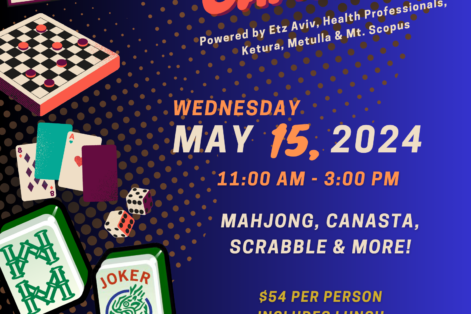Despite years of deep and continuous research, the human mind remains largely a mystery to us. However, clinicians are learning more about the inner workings of our psyche every day, especially when related to trauma. One area of therapy, EMDR (Eye Movement Desensitization and Reprocessing), was developed in 1987 by Dr. Francine Shapiro to help individuals living with the effects of trauma.
From helping children with family-based abuse to veterans coping with PTSD, EMDR has proven to be effective in treating many types of traumas. The therapy works with the connection between the mind’s natural ability to process information and the body’s adaptive responses to threats.
JF&CS Therapist and Licensed Clinical Social Worker, Lauren Wishneff, specializes in working with adolescents and adults with behavioral and emotional struggles. She is certified and practices Somatic and Attachment Focused (SAFE) EMDR Therapy.
“During a crisis, we become hypervigilant, our heart rate increases, adrenaline flows, and the brain is very aware and active,” Lauren says. “After the trauma, our bodies work to repair the tissue and heal themselves. Those feelings and memories remain as fragments, and may stay in that part of the brain, unable to be released.”
EMDR Explained
Trauma is a unique phenomenon, and those who suffer from it often feel the traumatic event is happening right now, instead of in the past. EMDR works by aiming to move memories of trauma from one part of the brain to another, which helps the person feel more present and recognize that the trauma is behind them.
Lauren explains: “Most memories are functionally stored, meaning they have a time-stamp, and we can recognize that they have occurred in the past and are a memory,” Lauren says. “We could say that they are a file, being stored in a logically organized file cabinet.
“However, when a traumatic event happens, that memory gets stored in a part of the brain called the amygdala, which has no coherent sense of time. It is the survival part of the brain. It is where we experience fight, flight, freeze, and submit. Because the memory is not time-stamped, it cannot be stored in the file cabinet as a memory. It gets stuck. This can lead to a client feeling like the event is happening in the present moment.
“EMDR moves that memory from the survival part of the brain to the hippocampus, a part of the brain that has logic and structure. It integrates the memory, so it has a coherent sense of time.”
How EMDR Works
Whereas traditional therapy will work with a person’s conscious thoughts and requires a lot of talking, EMDR is different. It works with the conscious, subconscious, and body’s physical reactions to heal.
Lauren clarifies: “EMDR activates the limbic system which is the emotional part of the brain, as opposed to the prefrontal cortex, which is the rational part of the brain. It is also different from hypnosis. The client is always aware and in control. If they need to stop, they can just hold up a hand or say ‘stop.’
“Trauma is very physical, and it’s stored in the part of our brain that has no language sensor,” Lauren continues. “So even if we want to talk about the memory, we sometimes can’t because there is no language. EMDR utilizes ‘bilateral stimulation’ to create a cohesive memory. Bilateral Simulation is any back-and-forth type of movement.”
Lauren defines this movement by saying some of her clients might tap on themselves. Others move their eyes back and forth. The therapy uses electronic devices called buzzers that pulse when you hold them in your hands. She adds that the bilateral aspect is important: “It is through the linking of both hemispheres that we can begin to integrate the memory, adding language and time to fragments of memories that are stored in flashes of sensation.”
The Phases of EMDR
EMDR is a process, and it relies on eight phases to reduce the intensity of experienced traumas and the emotions associated with them. This can be as serious as major traumas such as those experienced in a war zone, or smaller traumas such as being pushed off a swing as a child. No matter the trauma, the process is the same and can help those living with it.
Though these phases are typically described with numbers, they don’t always happen one after the other. Often different phases need to be repeated. Lauren recalls a client that was in phase two for a year to get them ready to move on, and says there is no “right” or “wrong” way to take this therapeutic approach.
The phases are outlined below:
History taking and treatment planning
The first phase involves finding out why the person is wanting EMDR therapy. The therapist will ask about symptoms and potential triggers, as well as strengths. They’ll then usually map out some treatment goals specialized to the individual patient.
Preparation
From information gathered in the first phase, the therapist will plan out how they can best proceed. This is phase two.
“It’s finding a way to get the person from a place of emotional disturbance to a more regulated state,” Lauren says. There’s a multitude of strategies that can help, such as meditations, self-control techniques, compartmentalization, etc.
“Someone who has been through trauma is in survival mode,” Lauren explains. “They have a very small window of tolerance for thinking about and experiencing uncomfortable memories. In phase two, we try to expand that window of tolerance. Otherwise, it may be too much or unsafe for the client to move forward.”
Assessment
Phase three is when the person concentrates on the memory of a trauma and the limbic system, the emotional part of the brain, is activated. “There’s a series of questions that you ask to really light up the limbic system for the client. Then the client is really in it, feeling their emotions,” says Lauren.
During phase three, the client will look at the most disturbing part of the trauma. They explore the negative beliefs associated with it and what they want to believe about themselves instead. They concentrate on the emotions brought up as they think about the memory and where they feel it in their body. The therapist also asks the client how disturbing the memory is and works with kindness and patience as their client works through this difficult phase in the process.
Reprocessing
Phase four is the bilateral stimulation of EMDR. “That’s when there’s tapping, or they’re following my finger back-and-forth with their eyes. You do a certain number of sets and each time I ask them what they are noticing,” Lauren explains.
Through each set, the therapist will ask more questions to assess the person’s emotional state. “You keep doing the bilateral stimulation until you start to hear a more positive association to the memory, like ‘It wasn’t my fault. I was just a kid.’ Or they start talking about other memories. That means the memory has probably moved out of the amygdala because they’re not as immersed in it anymore. When the client no longer finds the memory disturbing, we then move into phase five, Installation.”
Installation
At this phase, the therapist will work with the client to install a positive belief they have about themselves, replacing the old belief associated with the memory. With their mind centered on the positive belief, the therapist will do more bilateral stimulation. “The bilateral stimulation not only can move a memory, but it can also reinforce the positive cognition as well. You continue to do that until that person believes the positive version more than the negative.”
Body Scan
The sixth phase of EMDR starts the process of wrapping up the session. “We want to make sure the body is clear from any residual disturbance,” says Lauren. The client makes sure that there is no tension, tightness, or unusual sensations related to the memory. The therapist continues the bilateral stimulation until the client has a clear body scan.
Closure
In this phase, the therapist will emphasize stress reduction techniques and will maintain a record of disturbances. They also coach the client on how to manage any stress, emotions or crisis that may occur between sessions to help them be prepared for life outside of the office.
“If they still feel disturbed then we use one of the resources that we developed in phase two, so they feel regulated and ready to continue their daily life,” Lauren says.
Evaluation
Phase eight typically happens in the next session. That is when the memory and what was experienced is reevaluated.
“We check in and see where they are. Is the memory we went over still disturbing? The reprocessing may still be going on. Sometimes, when they come back, if it is still disturbing, we do the process again about the same trauma,” Lauren explains.
EMDR is the most researched therapeutic modality relating to trauma. JF&CS has several clinicians that are trained to perform the treatment with adults and children. EMDR is most commonly used for traumatic experiences, but studies have also shown that it’s useful for depression, anxiety, chronic pain, panic disorders and more.
JF&CS is here to help. If you’re interested in learning more about EMDR, or talking to a therapist about whether this type of therapy is right for you, please contact the JF&CS Frances Bunzl Clinic.
This post has been contributed by a third party. The opinions, facts and any media content are presented solely by the author, and Atlanta Jewish Connector assumes no responsibility for them. Want to add your voice to the conversation? Publish your own post here.



































































